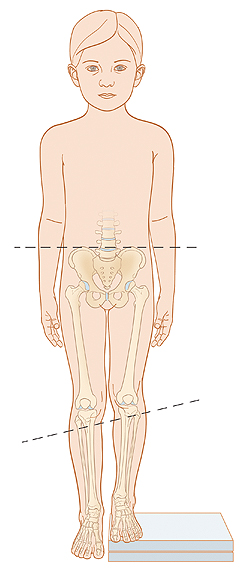Your child has been diagnosed with a leg-length discrepancy. This means that your child’s legs are slightly different lengths, with one leg longer than the other. The difference in lengths can vary widely. The larger the difference in lengths, and the younger the child, the more problems that can result as the child gets older. Because of this, your child may be referred to a pediatric orthopedist. This is a healthcare provider specializing in treating bone and joint problems in children.
What are the causes of leg length discrepancies?
LLDs are very common. Sometimes the cause isn’t known. But the known causes of LLD in children include:
-
Injury or infection that slows the growth of a leg bone
-
Injury to the growth plate. This is a soft part of a long bone that allows the bone to grow. Growth plate injury can slow bone growth in that leg.
-
A break or fracture to a leg bone that causes overgrowth of the bone as it heals
-
A problem that is present at birth (congenital). For example, a whole side of the child’s body may be larger than the other side.
-
Conditions that affect muscles and nerves, such as polio
How are leg length discrepancies diagnosed?
-
The healthcare provider carefully examines the child. They check to be sure the legs are actually different lengths. This is because problems with the hip (such as a dislocated joint) or back (scoliosis) can make it seem like a leg is shorter, when both legs are the same length.
-
An X-ray of the child’s legs is taken. During the X-ray, a long ruler is put in the image so an accurate measurement of each leg bone can be taken. Sometimes a CT scan is used.
-
If an underlying cause of the discrepancy is suspected, more tests are done to further evaluate.
How are leg length discrepancies treated?
Treatment for an LLD depends on the amount of difference and the cause, if known. The healthcare provider will discuss treatment options carefully with you and your child before any decisions are made. Treatment is planned with your child’s final height and leg lengths in mind, not the current leg lengths.
Treatment is generally not needed if the child’s final LLD is predicted to be
Treatment is often advised for LLDs predicted to be more than
-
A “lift” in a shoe to level the child’s hips. An orthopedic shoe insert or lift is often the only treatment needed for small discrepancies.
-
Surgery to shorten the longer leg. This is less complicated than lengthening the shorter leg. Shortening may be done by:
-
Closing the growth plate of the long leg
2 to 3 years before growth ends (around age11 to 13 ), letting the short leg catch up. This procedure is called an epiphysiodesis. -
Or taking some bone from the longer leg, once growth is complete, to even out leg lengths.
-
-
Surgery to lengthen the shorter leg. This surgery is more complex than surgery to shorten a leg. During this surgery, cuts are made in the leg bone. An external metal frame and bar are attached to the leg bone. This frame and bar slowly pull on the leg bone, lengthening it. The frame and bar must be worn constantly for months or years. When the frame and bar are removed, a leg cast is often needed for a few months. This surgery requires careful and continued follow-up with the surgeon to be sure that healing is going well.
-
Physical therapy to strengthen and lengthen muscles. This is especially helpful after surgery.
What are the long-term concerns?
A child with an LLD often has no activity restrictions. Treatment often leads to a good result. If a larger LLD is not treated, back, hip, and knee problems often occur as the child grows.


